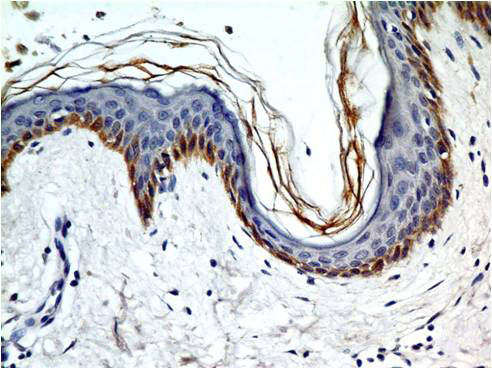anti-TLR5 (human) mAb (ABM22G1)
| Code | Size | Price |
|---|
| AG-20T-0304-C100 | 100 ug | £340.00 |
Quantity:
Prices exclude any Taxes / VAT
Overview
Antibody Clonality: Monoclonal
Regulatory Status: RUO
Target Species: Human
Applications:
- Fluorescence-activated cell sorting (FACS)
- Immunohistochemistry (IHC)
Shipping:
-20°C
Storage:
Short Term: 4°C Long Term: -20°C
Images
Documents
Further Information
Alternate Names/Synonyms:
Toll-like Receptor 5; Toll/interleukin-1 Receptor-like Protein 3; TIL3; MELIOS; SLE1; SLEB1
Concentration:
0.5mg/ml
EClass:
32160000
Form (Short):
liquid
Formulation:
Liquid. In PBS containing 0.05% BSA and 0.05% sodium azide.
Handling Advice:
After opening, prepare aliquots and store at -20°C.Avoid freeze/thaw cycles.
Immunogen:
Recombinant human TLR5 protein (aa 261-420).
Long Description:
Monoclonal Antibody. Recognizes human TLR5. Isotype: Mouse IgG2akappa. Clone: ABM22G1. Applications: FACS, IHC. Liquid. In PBS containing 0.05% BSA and 0.05% sodium azide. TLR5 (Toll-like Receptor 5) is a member of the Toll-like receptor (TLR) family which plays a fundamental role in pathogen recognition and activation of innate immunity. TLR5 recognizes bacterial flagellin, a principal component of bacterial flagella and a virulence factor, via a conserved region within flagellin, the D1 portion/domain. Binding of flagellin induces the dimerization of TLR5, which in turn recruits MyD88. The recruitment of MyD88 leads to subsequent activation of IRAK4, IRAK1, TRAF6 and eventually IkappaB kinases. Activation of IkappaB kinases mobilizes the nuclear factor NF-kappaB and stimulates many downstream gene expressions, which initiate the canonical proinflammatory pathway, including TNF-alpha production. TLR5 may play a role in inflammatory bowel disease (IBD). Lower levels of TLR5 expression have been found in patients exhibiting moderate to severe ulcerative colitis (UC). TLR5 is suggested to be possibly involved in HPV induced inflammation and subsequent cervical neoplasia formation. It has been reported that TLR5 expression is detected in both ovarian epithelium and ovarian cancer cell lines, suggesting a possible role of TLR5 in inflammation induced ovarian cancer onset. Mutations in this gene have been associated with both resistance and susceptibility to systemic lupus erythematosus and susceptibility to legionnaire disease, highlighting the importance of TLR5 in microbial recognition particularly at the mucosal surface.
Package Type:
Plastic Vial
Product Description:
TLR5 (Toll-like Receptor 5) is a member of the Toll-like receptor (TLR) family which plays a fundamental role in pathogen recognition and activation of innate immunity. TLR5 recognizes bacterial flagellin, a principal component of bacterial flagella and a virulence factor, via a conserved region within flagellin, the D1 portion/domain. Binding of flagellin induces the dimerization of TLR5, which in turn recruits MyD88. The recruitment of MyD88 leads to subsequent activation of IRAK4, IRAK1, TRAF6 and eventually IkappaB kinases. Activation of IkappaB kinases mobilizes the nuclear factor NF-kappaB and stimulates many downstream gene expressions, which initiate the canonical proinflammatory pathway, including TNF-alpha production. TLR5 may play a role in inflammatory bowel disease (IBD). Lower levels of TLR5 expression have been found in patients exhibiting moderate to severe ulcerative colitis (UC). TLR5 is suggested to be possibly involved in HPV induced inflammation and subsequent cervical neoplasia formation. It has been reported that TLR5 expression is detected in both ovarian epithelium and ovarian cancer cell lines, suggesting a possible role of TLR5 in inflammation induced ovarian cancer onset. Mutations in this gene have been associated with both resistance and susceptibility to systemic lupus erythematosus and susceptibility to legionnaire disease, highlighting the importance of TLR5 in microbial recognition particularly at the mucosal surface.
Purity:
Protein G purified.
Specificity:
Recognizes human TLR5.
Transportation:
Non-hazardous
UNSPSC Category:
Primary Antibodies
UNSPSC Number:
12352203
Use & Stability:
Stable for at least 1 year after receipt when stored at -20°C. Stable for at least 6 months after receipt when stored at +4°C.



